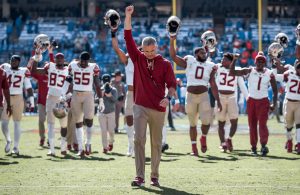- Sunday Seminole Summary: FSU Football Adds Pair of WR Transfers
- Sunday Seminole Summary: FSU Football Exits ESD With Top-15 Class
- Sunday Seminole Summary: FSU Soccer Tops BYU for Third National Championship
- Sunday Seminole Summary: FSU Soccer Advances to National Championship Match
- Seminole Sunday Summary: FSU Soccer Heads Back to College Cup
- Seminole Sunday Summary: FSU Soccer Reaches Sweet 16; Football Tops Boston College
- Seminole Sunday Summary: FSU Soccer Wins ACC, Advances to Second Round of NCAA Tournament; FSU Football Rallies Past Miami
- Seminole Sunday Summary: FSU Soccer Tops Wake on OT to Advance to ACC Final
- Seminole Sunday Summary: FSU Football Crushes UMass for Third Straight Win
- Seminole Sunday Summary: FSU Soccer Stays Perfect with Pair of Wins
Taggart Files: Proven Team Academic Success
- By Clint Eiland
- Updated: May 26, 2018
 Ross Obley/FSU athletics
Ross Obley/FSU athleticsThe NCAA released academic progress rates (APR) for the 2016-17 academic year on Wednesday afternoon. Florida State football APR made a slight improvement in the multi-year rate and a huge improvement in the single-year rate, but still lagged behind its fellow athletic teams, as well as the rest of the Power 5 schools.
APR is a tool the NCAA uses to maintain academic standards among its member schools. The specifics of what go into it aren’t relevant to the purposes of this article, but here is the link for those wondering. The two numbers that matter for now are the multi-year APR rate and the single-year APR rate.
The multi-year rate is a rolling 4-year average, while the single-year rate is for that specific academic year. A multi-year APR rate above 930 is required to compete in championships and avoid sanctions.
For the 2016-17 year, Florida State football raised its multi-year rate to 941. While that obviously clears the bar, it also leaves the Seminoles dead last for both the ACC and Power 5 programs at large.
The single-year rate shows drastic improvement however. Florida State recorded a rate of 966, which is up from an abysmal 918 in the 2015-16 year. It should have never gotten that low in the first place, but former head coach Jimbo Fisher had trouble keeping his players committed in the classroom throughout his tenure.
Starting in the 2012-13 academic year, the FSU football APR declined for four straight years. That applies to both the multi-year rate and the single-year rate.
Willie Taggart, the new head coach of the Seminoles, has plans to change all that. Ira Schoffel of Warchant recently published a story where he spoke to various sources within the program about the new coaching staff’s focus on academics. Taggart and his crew received high marks from those quoted in the story, who help describe some of the ways Taggart looks to improve the FSU football APR.
Prior to Florida State, Taggart made stops at Western Kentucky, South Florida, and Oregon. For at least the first two schools, he stayed long enough to examine his APR results. He obviously feels the need to mention his commitment to keeping his players on track academically. What does the history indicate?
Some notes before diving in to the numbers:
The academic year setup complicates the task. A coach who arrives at the end of the fall semester or leaves before the spring semester is still partly responsible for the team’s APR. So while the numbers need to be included, some caution needs to be taken with attributing it to just one coach.
This means that Western Kentucky’s 2009-10 rate, its 2012-13 rate, USF’s 2012-2013 rate, its 2016-17 rate, and Oregon’s 2016-17 rate are “split” between Taggart and the previous coach or new coach.
We calculated the single-year APR average to remove the “bias” of the multi-year rate. Since coaches take over for someone else, their first three APR rates are going to include numbers from a different staff. Though both coaches stayed at a destination long enough to have a multi-year APR rate solely attributed to them.
Final note is that APR is not the end-all be-all of academic indicators. It has problems and should not be taken as indisputable.
Below are the APR rates for Florida State football from the 2010-11 year through the 2016-17 year. This is the tenure of Jimbo Fisher.
Florida State
| Florida State | Multi-Year APR | Single-Year APR |
| 2010-2011 | 937 | 971 |
| 2011-2012 | 954 | 941 |
| 2012-2013 | 958 | 956 |
| 2013-2014 | 955 | 946 |
| 2014-2015 | 945 | 934 |
| 2015-2016 | 939 | 918 |
| 2016-2017 | 941 | 966 |
| Average | 947 | 947.4 |
Problems arose for Fisher back in 2013-14 and continued for some time. Recording single-year rates of 934 and 918 should’ve been massive red flags, and they will drag down the multi-year APR rate for 2017-18 when those get released.
Here are the APR rates for the Hilltoppers and Bulls during Willie Taggart’s time at each school:
Western Kentucky
| Western Kentucky | Multi-Year APR | Single-Year APR |
| 2009-2010 | 959 | 954 |
| 2010-2011 | 951 | 940 |
| 2011-2012 | 950 | 963 |
| 2012-2013 | 952 | 949 |
USF
| USF | Multi-Year APR | Single-Year APR |
| 2012-2013 | 973 | 983 |
| 2013-2014 | 970 | 954 |
| 2014-2015 | 958 | 936 |
| 2015-2016 | 965 | 990 |
| 2016-2017 | 960 | 956 |
The Oregon multi-year APR for 2016-17 was 969 and Taggart’s single-year APR was 958.
With these three averaged out, it comes to 960.7 for the multi-year and 958.3 for the single-year. Those are significant improvements from Fisher and bode well for Taggart’s promises. After looking at the numbers, it seems that he has the results to back it up.
A team under Taggart’s coaching has dipped below 940 just once. He promptly corrected course and shot back up to 990, which is an exceptional number by any comparison. His USF teams had some fluctuation, but they were more in line with what Florida State is trying to accomplish.
While Taggart’s averages might not top the charts, it would still be a much-needed improvement for the FSU football APR. A 960 score places 64 spots higher than Florida State’s current standing and a 958 score would be 56 spots higher.
Truthfully, the APR rates don’t matter that much in the grand scheme of the sport. As long as you’re above 930, you can compete at the highest level.
It would still be encouraging to see academic improvement after the last staff let it nearly bottom out. Taggart stated that his primary goal right now is to get the team GPA to 3.0 overall. That’s a commendable and certainly achievable task.
Should a flawed metric with little consideration for circumstance retain so much influence? How long will the NCAA try and deny the growing separation between the student and the athlete?
Who knows. But those are conversations for another time.
Right now, fans should be relieved that Taggart walks it like he talks it.




You must be logged in to post a comment Login